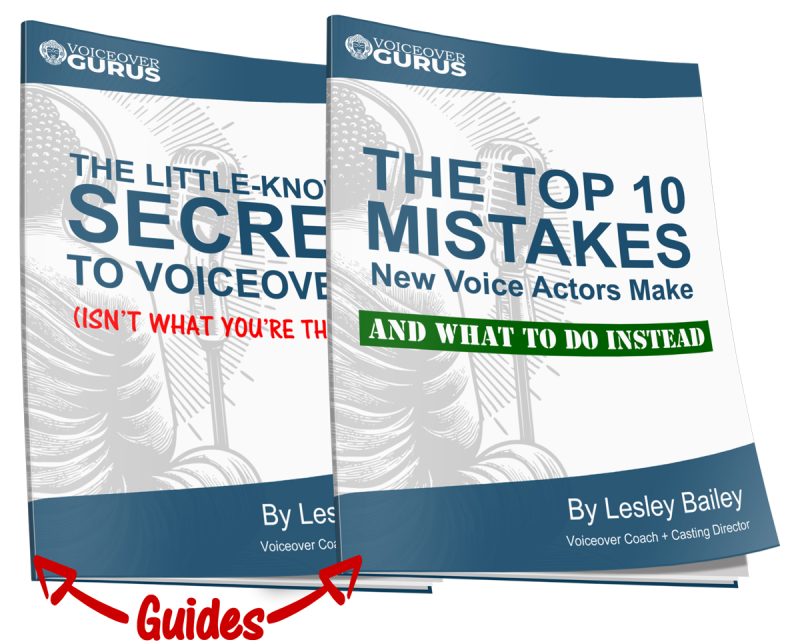There are many ways to sound real on your voiceover demo, but the most important thing is knowing yourself. People usually make one of two mistakes when preparing material for the demo. The first is trying to be a jack of all trades and having every single spot be insanely different in terms of personality. An example would be a mid-twenty-something female having this “range” on her demo: young harried mom, crazy best friend, dreamy romantic girl, cosmetic smooth voice, and a driven tough sneakers/deodorant gal. Another might be a guy in his mid 40’s doing friendly caring dad, trusted banker, sarcastic guy, masculine razor/beer guy, and quirky neighbor. Now, by all means if you have this kind of range, show it to the world. But before you “have range”, get perspective from a professional on how you REALLY sound. The subjective and the objective there can be vastly different. My own personal example would be singing loudly to the music and thinking I’m wasting my talents as a voice over coach, but as soon as the music stops and it’s just my voice alone without the aid of Beyonce accompanying me, well, that’s my way of being told by the universe how I really sound. Ouch. I digress. The second mistake made on demos is doing the exact same thing 5 or 6 spots in a row. Yes, there are one-trick ponies out there who do really well with this, but it’s not sustainable for most. It’s not a way to build a career. The secret here is a balance of the two.
I’m going to talk about the balance of personality you want on your demo in just a sec, but I do want to get back to the “sounding real” teaser that I promised at the very beginning of this voice over article. Part of having balance on your demo is actually intertwined with sounding real, so don’t think I’m straying from the subject. You sound “real” by being authentic. You find your authentic voice by, wait, that’s a whole ‘nother blog article. Yes, it’s called Tools for Authenticity. When you have found your authentic voice, you have found your money voice. For people to get a sense of the real you on your demo, you want to have several examples of the “read” that defines the best/most authentic part of you. This way your demo is not giving them emotional whiplash, it’s not Jekyll and Hyde. By having a few spots that slighty repeat the aspect of your personality that most flatters you and is marketable, you allow your listener to actually connect to who you are as a voice actor but also as a person. This builds trust. You’re not duping them in any way, you’re revealing who you are. Sprinkle this with a few spots that maintain that integrity but layer in a few more key expressions of style/emotion and now you make sure you also keep them surprised and interested. Balance. No different than having the right amount of sauce and cheese to the right amount of crust. Apologies, my obsessions often seem to leak in to the best of these voiceover blogs.
Back to what so many of you have really been waiting for – how to sound real in voiceovers so you can book tons of jobs and get rich. Or at least just pay this month’s rent. Or at least just have fun through a means of finally expressing yourself creatively? So, sounding real is at the crux of the modern day voice over. It has been requested so much in breakdowns by producers and writers and directors that it has many names now – natural, believable, authentic, conversational, off-the-cuff, relaxed. Yes, even relaxed has come to mean real. The reason is that it is the opposite of the adrenaline-fueled, big-voiced announcer from long ago that shouted at us with urgency to buy that new Remember that the microphone is not only a recording device but in a sense is an amplifier of sorts as well. Less is more. When you have acquired the necessary equipment, you can easily see what I mean by recording the same spot about four times. Start your first read at an energy/volume/excitement level of 0 and build up in increments to a ten. Play them back for yourself and you will most likely find that somewhere in the middle is your sweet spot. It’s certainly not at a ten. A ten is simply where the headache is born. Once you have heard for yourself what your actual reads sound like through the mic, you can adjust. Now, bring your method acting possibilities in to play here. Recall an experience that mimics in style/tone/emotion where your voiceover spot should land. Really remember what it felt like, sounded like, looked like, etc…..You are faced with the challenge of using these new words to apply those feelings through, but the feelings are yours alone, and that is authentic no matter what it is the script has you “saying.” Always more important than the saying, is the BEING. I truly believe that there is always a “truth” somewhere, even in commercials. That truth most likely comes from the writer, through some subconscious need, unresolved feeling, something….and this comes out through the way they design the tone or story around the product they are pitching. Maybe that writer feels taken for granted by people, or is afraid to be assertive. In this spot he may decide to write the character as a true, take-no-prisoners badass. Does it fit with the product? Maybe not. But you’d be quick to write it off as bad-writing, or fake, or anything else for that matter – if you’re going to audition for the job. SOMEONE will embrace the truth in there, and that someone will book that job. Let it be you. So, find the motivation in the writing, look carefully to pick up the clues. I get more specific in a previous blog about Voiceover Script Analysis, so check it out if you need starting points. There is also a series of blog entries that follow it which break down many individual scripts and go line by line through the investigative work. Back to truth in writing for a moment. I do want to leave some room for the fact that perhaps there won’t always be a truth, or you won’t find it, or something. It could just be one of those days you or the writer were not getting his message connected between the two of you. This is where you must find YOUR own truth in the writing. Maybe it’s a story of a lost puppy trying to find his way home, but you’re not a dog person. Have you ever gotten lost in your entire life? Yes. Of course you have. I remember still being lost in a supermarket even though my mother was most likely aisles away and though it probably lasted two minutes, it felt like 2 hours. There is my instant truth in this story. I’m now instantly connected to this puppy as I have empathy. Truth. In everything. You’ll win every time.
Back to sounding real on your demo reel. Based on everything we just discussed here, make sure when selecting demo material that you choose things where the truth is very clear, upfront, and personal for you. This is the luxury you will have ONLY for your demo. When you audition, you deal with what is there and make the best of it, but when choosing scripts for your demo, you get to be supremely picky. Choose scripts that speak to the highest truth(s) in you as far as personality traits go (don’t get the most sarcastic spot out there if you ooze straightforward sincerity no matter how hard you try), your belief system goes (don’t get that McDonald’s script of you’re vegan), and your energy style can handle (if you are the mellow type don’t bother with the “racing-car” script). Be true to yourself and what your range is, honor it, and you will be practicing authenticity before you’ve even stepped up to the mic. It’s a win win.


 Hi! I’m Lesley Bailey. I’m an award-winning Casting Director, Voiceover Coach, Demo Producer, and Consultant with over 30 years “in the trenches”. I love helping voice actors bring scripts to life with authenticity and confidence.
Hi! I’m Lesley Bailey. I’m an award-winning Casting Director, Voiceover Coach, Demo Producer, and Consultant with over 30 years “in the trenches”. I love helping voice actors bring scripts to life with authenticity and confidence.